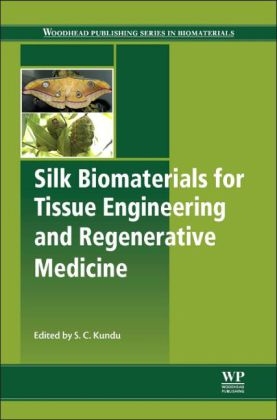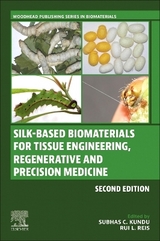
Silk Biomaterials for Tissue Engineering and Regenerative Medicine
Woodhead Publishing Ltd (Verlag)
978-0-85709-699-9 (ISBN)
- Titel erscheint in neuer Auflage
- Artikel merken
Silk is increasingly being used as a biomaterial for tissue engineering applications, as well as sutures, due to its unique mechanical and chemical properties. Silk Biomaterials for Tissue Engineering and Regenerative Medicine discusses the properties of silk that make it useful for medical purposes and its applications in this area.
Part one introduces silk biomaterials, discussing their fundamentals and how they are processed, and considering different types of silk biomaterials. Part two focuses on the properties and behavior of silk biomaterials and the implications of this for their applications in biomedicine. These chapters focus on topics including biodegradation, bio-response to silk sericin, and capillary growth behavior in porous silk films. Finally, part three discusses the applications of silk biomaterials for tissue engineering, regenerative medicine, and biomedicine, with chapters on the use of silk biomaterials for vertebral, dental, dermal, and cardiac tissue engineering.
Silk Biomaterials for Tissue Engineering and Regenerative Medicine is an important resource for materials and tissue engineering scientists, R&D departments in industry and academia, and academics with an interest in the fields of biomaterials and tissue engineering.
Subhas C. Kundu, PhD, is a Research Coordinator and former European Research Area Chair and Professor at the 3B´s Research Group, I3Bs – Institute on Biomaterials, Biodegradables and Biomimetics of the University of Minho, Portugal. His research interests include silk biomaterial matrices for biomedical applications, including 3D in vitro cancer models for investigating tumour growth and progression. In addition, he is using natural-based biomaterials for 3D cancer modelling and drug screening.
Contributor contact details
Woodhead Publishing Series in Biomaterials
Foreword
Part I: Fundamentals, processing and types of silk biomaterials
Chapter 1: Introduction to silk biomaterials
Abstract:
1.1 Introduction
1.2 General information about silkworms
1.3 Silk proteins
1.4 Genetics of silkworms
1.5 Diseases of silkworms
1.6 Applications of silks
1.7 Application of silk protein fibroins
1.8 Application of silk protein sericins
1.9 Conclusion
1.10 Acknowledgments
Chapter 2: Applications of silk biomaterials in tissue engineering and regenerative medicine
Abstract:
2.1 Introduction
2.2 Silk scaffolds in tissue engineering and regenerative medicine
2.3 Hard tissue engineering
2.4 Soft tissue engineering
2.5 Tissue engineering for application in specific organs
2.6 Conclusion and future trends
2.7 Acknowledgments
Chapter 3: Processing of Bombyx mori silk for biomedical applications
Abstract:
3.1 Introduction
3.2 Modulation of silk biomaterial properties
3.3 Silk fibroin materials and their use in biomedical applications
3.4 Conclusion and future trends
Chapter 4: Silk nanostructures based on natural and engineered self-assembly
Abstract:
4.1 Introduction
4.2 Mechanisms of self-assembly in natural and engineered systems
4.3 Assembly of natural and recombinant silk proteins
4.4 Engineering the self-assembly of silk
4.5 Silk nano-architectures and their applications
4.6 Self-assembly in conjugation with other (bio)materials
4.7 Conjugation with natural and synthetic materials
4.8 Conclusion and future trends
Chapter 5: Electrospun silk sericin nanofibers for biomedical applications
Abstract:
5.1 Introduction
5.2 Application of silk sericin in the biomedical field
5.3 Electrospinning
5.4 Silk sericin nanofibers from electrospinning
5.5 Molecular structure and physical properties
5.6 Silk sericin/silk fibroin blend nanofibers by electrospinning
5.7 Conclusion and future trends
Chapter 6: Silk fibroin microfiber and nanofiber scaffolds for tissue engineering and regeneration
Abstract:
6.1 Introduction
6.2 Silk fibroin (SF) microfibers for skin and connective tissue regeneration
6.3 Formic acid (FA)-cross-linked 3-D SF microfiber-based nonwovens
6.4 SF microfiber-based carded-needled 3-D nonwovens
6.5 Nanofibers from electrospinning and tissue engineering
6.6 Electrospun SF tubes for small calibre blood vessel regeneration
Chapter 7: Silk powder for regenerative medicine
Abstract:
7.1 Introduction
7.2 Silk particle production by the bottom up approach
7.3 Silk powder production by the top down approach (milling)
7.4 Characterisation of silk powder
7.5 Applications of silk particles
7.6 Conclusion
Part II: Properties and behaviour of silk biomaterials
Chapter 8: Biochemical and biophysical properties of native Bombyx mori silk for tissue engineering applications
Abstract:
8.1 Introduction
8.2 Genetic sequence and primary structure of silk proteins
8.3 Structure and assembly of native silk fibroin
8.4 Physical and chemical properties of native silk fibroin fibers
8.5 Conclusion
Chapter 9: Structure and properties of spider and silkworm silk for tissue scaffolds
Abstract:
9.1 Introduction
9.2 Microstructure of silks
9.3 Mechanical properties
9.4 Relationship between structure and properties
9.5 Biomimetic approaches
9.6 Conclusion
9.7 Acknowledgments
Chapter 10: Types and properties of non-mulberry silk biomaterials for tissue engineering applications
Abstract:
10.1 Introduction
10.2 Classification of silkworms
10.3 Life cycle of silkworms
10.4 Types of non-mulberry silk
10.5 Structure and mechanical properties of silk
10.6 Processing of silk proteins
10.7 Different formats of silk protein as biomaterials: fibroin
10.8 Different formats of silk protein as biomaterials: sericin
10.9 Applications of non-mulberry silk protein as biomaterials in biomedicine and biotechnology
10.10 Immunological response to silk
10.11 Silk degradation
10.12 Conclusion and future trends
Chapter 11: Bio-response to silk sericin
Abstract:
11.1 Introduction
11.2 Biological responses to biomaterials
11.3 Aspects of tissue responses to biomaterials
11.4 Evaluation of biological responses to biomaterials
11.5 Significant issues in in vivo testing
11.6 Reports on biological responses to silk sericin
11.7 Investigation of biological responses to silk sericin
11.8 Clinical investigation of silk sericin
11.9 Conclusion
11.10 Acknowledgement
Chapter 12: Biodegradation behavior of silk biomaterials
Abstract:
12.1 Introduction
12.2 In vitro biodegradation behavior of silk fibroin materials
12.3 In vivo biodegradation behavior and inflammatory responses of silk fibroin materials
12.4 Biodegradation behavior of sericin
12.5 Conclusion and future trends
Chapter 13: Capillary growth behavior in porous silk films
Abstract:
13.1 Introduction
13.2 Growth model of capillaries
13.3 Growth process of capillaries
13.4 The model of oxygen diffusion of the capillary and capillary density
13.5 The construction of capillary systems in biomaterials
13.6 Discussion on the oxygen concentration around a capillary
13.7 Growth process of capillaries in porous silk fibroin films (PSFFs) implanted into the dermis
13.8 Forms of angiogenesis in PSFFs after implantation
13.9 Conclusion
13.10 Acknowledgment
Part III: Tissue engineering, regenerative medicine and biomedical applications of silk biomaterials
Chapter 14: Silk biomaterials for intervertebral disk (IVD) tissue engineering
Abstract:
14.1 Introduction
14.2 Suitability of using silk as a biomaterial in tissue engineering
14.3 Key factors to be considered before IVD tissue engineering
14.4 Tissue engineering approaches to regenerate the hierarchical architecture of IVD
14.5 Conclusions
Chapter 15: Silk scaffolds for dental tissue engineering
Abstract:
15.1 Introduction
15.2 Clinical challenges in dentistry
15.3 From tooth development to repair
15.4 Dental tissue engineering
15.5 Silk-based biomaterial scaffolds for dental tissue engineering
15.6 Conclusion and future trends
Chapter 16: Silk for cardiac tissue engineering
Abstract:
16.1 Introduction
16.2 Current therapies and their limitations
16.3 Potential strategies to treat heart disease
16.4 Specific requirements for cardiac tissue engineering
16.5 Silk protein fibroin for cardiac tissue engineering
16.6 Conclusion
16.7 Acknowledgements
Chapter 17: Silk for dermal tissue engineering
Abstract:
17.1 Introduction
17.2 Human skin structure, wound healing and substitute assisted wound healing
17.3 Physical properties and processing options of silk fibroin
17.4 Dermal tissue engineering using silk fibroin
17.5 Silk fibroin films, membranes and coatings
17.6 Silk fibroin hydrogels
17.7 Silk fibroin porous sponges
17.8 Silk fibroin micro-/nano-fibrous scaffolds
17.9 Conclusion and future trends
Chapter 18: Silk scaffolds for three-dimensional (3D) tumor modeling
Abstract:
18.1 Introduction
18.2 Biological background
18.3 Three-dimensional (3D) in vitro tumor modeling: bridging theory and clinical applications
18.4 Methods of 3D in vitro tumor modeling
18.5 How silk-based tissue engineering applications can help cancer research
18.6 Future trends
18.7 Conclusion
Chapter 19: Silk hydrogels for tissue engineering and dual-drug delivery
Abstract:
19.1 Introduction
19.2 Gelation of silk with ethanol
19.3 Mechanical properties and molecular networks
19.4 Bound and bulk water contents in silk hydrogel
19.5 Cell viability (cytotoxicity)
19.6 Silk-based dual-drug delivery system: hydrogels containing nanoparticles
19.7 Dual-drug release behavior from silk hydrogel
19.8 Conclusion and future trends
19.9 Acknowledgment
Chapter 20: Silk for pharmaceutical and cosmeceutical applications
Abstract:
20.1 Introduction
20.2 Sources of silk
20.3 Properties of silk
20.4 Methods of fabrication
20.5 Types of formulations
20.6 Pharmaceutical applications of silk
20.7 Dermatological applications
20.8 Conclusion
Index
| Reihe/Serie | Woodhead Publishing Series in Biomaterials |
|---|---|
| Verlagsort | Cambridge |
| Sprache | englisch |
| Maße | 156 x 234 mm |
| Gewicht | 1010 g |
| Themenwelt | Technik ► Maschinenbau |
| Technik ► Umwelttechnik / Biotechnologie | |
| ISBN-10 | 0-85709-699-0 / 0857096990 |
| ISBN-13 | 978-0-85709-699-9 / 9780857096999 |
| Zustand | Neuware |
| Informationen gemäß Produktsicherheitsverordnung (GPSR) | |
| Haben Sie eine Frage zum Produkt? |
aus dem Bereich



